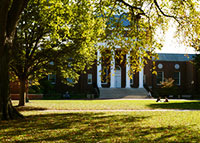Nov 23 2008
College students notoriously shun early morning, evening and Friday classes, but what if a change in schedules reduced a university’s carbon footprint.

“If we made a commitment to start classes early and also hold them on Fridays, this could help in not having to bring a new building on line,” said John Byrne, director of the University of Delaware’s Center for Energy and Environmental Policy and recent Nobel Peace Prize laureate.
Campus buildings are the largest source of carbon emissions on the campus of the University of Delaware. Proposals for methods of curbing the emissions fueled a lively discussion as the university recently unveiled the results of a six-month study that measured the sources of carbon dioxide released on the Newark, Del. Campus.
UD’s 2008 graduates paid for the study as its Senior Class gift to the university.
The study calculated the University's carbon emissions for waste, dining, transportation, landscaping and buildings. Transportation came in second behind buildings as a top contributor to the campus carbon footprint. Buildings account for 78.1 percent; transportation churns out 21.5 percent.
Contributing to the carbon emissions from buildings on campus were electricity (70 percent) and natural gas (29 percent), which are used to power, heat and cool residence halls, classrooms, laboratories and other buildings.
“Laboratories are energy intensive, and we need to see if there are ways we can improve on this,” Byrne said. “We also need to develop a multidimensional strategy for how we use energy generated by the six power plants on campus that heat and cool our buildings.”
While campus structures constitute the largest source of carbon emissions on campus, they also can serve as a framework to take advantage of renewable sources such as solar energy, Byrne said.
“We are collecting renewable energy on our buildings all the time,” Byrne said. “The problem is that we just don't use it.”’
The emissions associated with transportation were closely associated with students, faculty and staff commuting (86%).
“If this is going to work, we need to find ways for individuals to arrive and leave campus in ways other than carbon-using vehicles,” Byrne said.
University of Delaware President Patrick Harker has signed the American College and University Climate Commitment and the Talloires Declaration by the Association of University Leaders for a Sustainable Future.